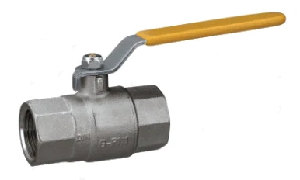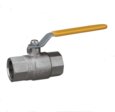Oxygen Valve Safety: Minimizing Potential Hazards

Figure 1: Oxygen ball valve
Certain materials react with liquid and gaseous oxygen at specific temperatures and pressures, resulting in fires or explosions. Due to these inherent hazards, carefully designing and selecting control valve materials when working with oxygen is crucial. This article is a comprehensive guide on the potential hazards of oxygen in control valves and guidelines to minimize them.
Table of contents
View our online selection of oxygen approved valves!
Common sources of localized high temperature
Control valves are made of materials that typically have high ignition temperatures, meaning they don't easily catch fire or ignite at normal operating temperatures. The real danger lies in situations where the valve or its surroundings experience abnormal, localized high temperatures, i.e., the temperature in a specific area can rise significantly higher than the normal operating temperature.
- Flow velocity: The materials used for valves in the oxygen service should meet the criteria for velocity outlined in the Compressed Gas Association Pamphlet G-4.4. If the velocity through the valve port exceeds 61 m/s (200 feet/s), use only copper-base alloy materials for the valve body and trim parts that come into direct contact with the flow stream.
- Foreign particle impingement: When the flow stream carries foreign particles, such as weld spatter, and strikes the valve trim or the wall of the valve body, their kinetic energy transforms into heat, potentially raising the impinging particle or the material it hits to its ignition temperature.
- Ignition by already-burning material: If an organic valve disk has been ignited due to foreign particle impingement, it can release enough heat to ignite nearby metallic materials, leading to a significant fire.
- Vibration: Vibration, typically caused by fluid velocity, generates heat through internal friction, potentially raising the temperature of a component to its ignition point.
- Adiabatic or rapid compression of gas: When a valve is opened to pressurize the downstream system, the rapid compression of the gas within the system can result in abnormally high gas temperatures. This high temperature can potentially ignite materials within the valve and piping system.
- Static electricity discharge: Gas flowing across the ball or butterfly valve trim creates an electric charge on the trim. These valves typically do not have a reliable grounding path from the trim to the valve body or from the valve body to the pipeline; it is crucial to take necessary precautions to ensure proper grounding. Neglecting this can result in sparks discharging between the trim and valve body or between the valve body and nearby piping, potentially causing ignition of the surrounding materials.
Ignition of common materials
ASTM G175 evaluates ignition sensitivity and fault tolerance of oxygen regulators. This section discusses the ignition characteristics of metals, organic and inorganic materials.
Organic materials
Organic materials have lower ignition temperatures compared to metals. Therefore, avoid using organic materials in direct contact with oxygen, particularly in the flow stream. When organic materials are necessary for components like valve seats, packing, or diaphragms, choose a material with the highest ignition temperature, the required mechanical properties, and the lowest specific heat. Table 1 shows approximate ignition temperatures for selected organic materials at 138 bar (2001 psi) oxygen.
Table 1: Typical ignition temperatures of common organic materials
Material |
Typical ignition temperature at 138 bar (2001 psi) oxygen |
|
| Degree Celsius | Degree Fahrenheit | |
| PTFE and PCTFE | 468 | 875 |
| 70% Bronze‐filled PTFE | 468 | 875 |
| Fluoroelastomer | 316 | 600 |
| Nylon | 210 | 410 |
| Polyethylene | 182 | 360 |
| Chloroprene and Nitrile | 149 | 300 |
Metals
Choose alloy materials that either do not get burned or can extinguish the flame quickly. This results in the least combustion after exposure to ignition events. Select the material based on its resistance to ignition and reaction rate. Resistance to ignition in oxygen materials is listed below in order (hardest to ignite to easiest to ignite):
- Copper
- Copper alloys
- Stainless steel (300 series)
- Alloys of nickel and copper
- Carbon steel
- Aluminum
The rate of combustion varies among materials. They are listed below in order from the slowest to the fastest rate of combustion:
- Copper, copper alloys, and nickel-copper alloys: These materials typically do not initiate combustion.
- Carbon steel: Carbon steel has a moderate combustion rate.
- Stainless steel (300 series): Stainless steel, once ignited, burns more quickly than carbon steel; still, the 300 series stainless steel is considered superior to carbon steel due to its high resistance to ignition.
- Aluminum: Aluminum has a very rapid combustion rate.
Non-metals
Soft components have a high probability of getting ignited in a valve due to adiabatic compression (compressing or squeezing a substance without any heat exchange with its surroundings) or mechanical impact. Minimize the use of non-metallic materials in the valve. However, when non-metals, such as seals, gaskets, packing, and lubricants, cannot be avoided, take sufficient precautions. One method is to surround the non-metallic parts with metals to act as heat sinks. This prevents direct exposure of soft components to the flow stream and avoids excessive movement.
General guidelines
These guidelines are crucial for ensuring the safe and appropriate selection of process equipment for gaseous oxygen service.
- Materials: All metals in contact with oxygen in the main flow stream should be appropriate for oxygen service.
- Use carbon steel, stainless steel, or cast iron for springs, diaphragm casings, diaphragm plates, and other parts not in the main flow stream.
- Use copper, copper alloy, or nickel-copper alloys for the valve body and trim parts in contact with the flow stream.
- Diaphragms in contact with oxygen gas should be made of fluoroelastomer.
- O-rings in contact with oxygen gas should be made of fluoroelastomer or a similar fluorocarbon elastomer.
- Avoid using organic materials for valve seats or other parts exposed to the flow stream.
- For soft goods, select physically and chemically stable materials under process conditions. Preferred soft goods materials include Teflon, PTFE, PCTFE, Kalrez, and Viton. However, impurities or composition variations can significantly compromise these materials' burn resistance.
-
Specific valve issues:
- Ball valves or butterfly valves open quickly, leading to adiabatic compression. Also, they have sharp leading edges. Rapid compression of gaseous oxygen can lead to combustion; however, their use is more acceptable with liquid oxygen.
- The valve body in a butterfly valve in its open state is a non-impingement site; however, the disk, steam, and seat are potential impingement areas as they come in direct contact with the fluid flow. A stainless-steel body may be acceptable, but more fire-resistant materials like Monel would be necessary for the internals.
- Filters: Place filters upstream of all regulators and valves to safeguard downstream processes. Use inorganic, non-ferrous filter elements to avoid ignition hazards. Regularly maintain and clean filters.
- Lubricants and sealing compounds: Ordinary petroleum lubricants are not suitable for oxygen service and pose a significant hazard due to their high heat of combustion and rapid reaction rate. Use lubricants and sealing compounds suitable for oxygen services, like oxygen-compatible greases or Perfluoropolyether (PFPE) lubricants. Also, use them sparingly.
- Pneumatic instruments and actuators: Minimize the number of parts in contact with oxygen by avoiding using oxygen as supply pressure to pneumatic instruments or actuators.
- Plated parts: Do not use plated (adding a thin layer of metal to the base material surface) parts in the main flow stream to prevent potential contributions to foreign particle impingement.
- Assembly and valve cleaning: The valve assembly for oxygen service should be done in a clean room. The various parts and assembly are handled with gloves or lint-free clothes. The tools used are free from dust and traces of hydrocarbon or oil. ASTM G93 prescribes any of the cleaning methods for valves in oxygen service:
- Aqueous cleaning: Using water-based cleaning solutions or detergents to remove contaminants from the surface of valves.
- Mechanical cleaning: Physically removing dirt, debris, or contaminants from the valve surfaces using techniques like brushing, scrubbing, or abrasive cleaning.
- Solvent cleaning: Using solvents, such as organic compounds or chemical cleaners, to dissolve or remove contaminants from the valve surfaces.
- Vapor degreasing: A volatile solvent is heated to produce vapors that condense on the valve surface, effectively dissolving and removing oils, greases, or other contaminants.
FAQ
How can I identify if a valve is suitable for oxygen service?
Look for valves that are explicitly labeled or certified for oxygen service and have undergone testing to ensure they meet the necessary safety standards.







